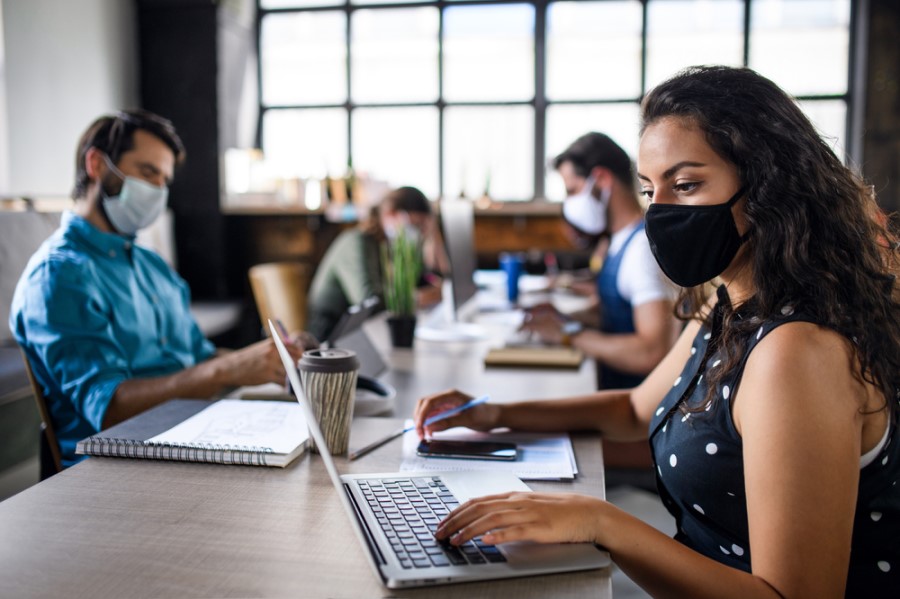Diane Rudge on how DWP supported colleague wellbeing throughout the Covid-19 pandemic

Diane Rudge, head of health and wellbeing at the Department for Work & Pensions (DWP), shares her experiences of how she has navigated and overcome the many challenges the last few months has brought DWP, to ensure all colleagues were supported with a first-class wellbeing offer during the crisis.
Wellbeing challenges at DWP
With more than 93,000 employees working in England, Scotland and Wales, DWP is the largest government department playing a crucial role in supporting the most vulnerable in society. It has a diverse workforce, with tens of thousands of colleagues working in key service delivery roles, many in Jobcentres, which remained open throughout the pandemic, through to those in office-based positions.
“Claims to unemployment benefits have more than doubled since March 2020, with Universal Credit caseload doubling to more than six million,” explains Rudge. “Building wellbeing and resilience has never been more important to DWP.”
The challenges for DWP were multi-faceted –some were practical, others physical and many emotional. From a practical perspective there was the need to support colleagues who were getting to grips with working flexibly and from home, many for the first time. As such, they deployed 72,000 devices to help people work remotely. However, remote working brought new social connectivity challenges, with many colleagues increasingly feeling lonely and socially isolated.
“We regularly surveyed our employees – approximately every six weeks – throughout the pandemic and we’re continuing to do so. This gave us invaluable insight into how our people were/are feeling and enabled us to continue to creatively enhance, refine and flex our wellbeing offer and services according to our peoples’ needs and business’ priorities throughout the pandemic,” says Rudge.
These insights revealed many employees were experiencing heightened levels of Covid-related anxiety. Others were struggling to come to terms with the loss of everyday life as the pandemic took hold and lockdowns emerged. The insights also showed that their colleagues had become fatigued both mentally and physically as the pandemic has gone on.
Steps to support employees
By using their insight and data the team were able to innovate, flex and adapt their offer to bring new pragmatic and practical services and programmes to meet employees’ changing needs over the course of the pandemic.
For example, they enhanced their bereavement offer with new care packs for colleagues and managers, as well as offering group loss and grief sessions facilitated by bereavement experts for colleagues who had lost a loved one or colleague in the workplace.
“We ran a virtual wellbeing roadshow – 30-minute bite-size sessions on topics colleagues told us were important to their wellbeing, such as normalising anxiety; managing long-Covid; self-care for carers; fatigue and burnout; social inclusion; and coping with the loss of everyday life,” says Rudge.
“In February 2021 alone we ran 140 sessions over 20 days engaging more than 25,000 colleagues, each session sponsored by a senior DWP leader. We’re now using this approach longer-term to continue to engage colleagues in our wellbeing offer and improve health outcomes.”
The team also provided bespoke support targeted at demographic groups with the greatest need. Lone parents, for example, were given access to bespoke emotional wellbeing support and a lone parents social intranet group was set up to support single parents throughout the pandemic and beyond.
For those feeling isolated and lonely, an informal wellbeing buddy network – connecting people across the organisation who wouldn’t ordinarily have met – was introduced to enable informal 10 minute check-ins to meaningfully ask how they were getting on and managing. Colleagues who were juggling childcare, home schooling and work were given access to sessions dedicated to caring for children during lockdown, to give parents top tips and practical advice to help them cope.
“Like most businesses we saw a dip in colleagues accessing wellbeing support at the start of the pandemic,” says Rudge. “So we got creative and adapted, tailored and better targeted our wellbeing offer and services, and rapidly adapted our delivery model to meet changing needs. We saw engagement with the support increase significantly as the pandemic took hold and as time went on.”
Leadership buy-in
Rudge explains that in DWP they have worked tirelessly to ensure wellbeing is at the centre of everything – “it’s now part of the way we think, part of our culture, part of our leadership”.
“Our senior leaders had wellbeing as a standing item on their team and senior leader meetings,” says Rudge. “Health, wellbeing and safety were at the heart of every meeting and every communication.”
She adds that having the support of their board-level Wellbeing Champion and Disability and Mental Health Champion has also been essential in getting leadership buy-in.
How wellbeing is making a difference
Since the start of the pandemic, DWP has seen satisfaction with its wellbeing support and services increase by 11 percentage points. During the same period their employee engagement score has risen, whilst absences have reduced, including mental health absences.
Rudge explains: “We developed wellbeing confidence training to build team wellbeing – virtually bringing teams together to talk about and explore their wellbeing in a safe environment using positive psychology principles. This has helped build confidence at all levels; people in teams now genuinely caring about each other’s wellbeing and many colleagues feel they can talk to their manager about their health and wellbeing.”
There have been a lot of learnings over the course of the pandemic that have taught Rudge and her team to be responsive, flexible, adaptive and creative as colleague and business needs and priorities changed. But there have also been broader impacts for their wellbeing approach.
“Our strategic wellbeing priorities for 2020 and 2021 have completely turned on their head. Although mental health has always been a top priority, it will become more so as we navigate out of Covid – we’re providing our people with more mental health support than ever – with EMDR and CBT therapies as standard, as well as considering a longer-term care model as part of our employee assistance programme (EAP). In addition, we are offering a new fatigue assessment to help our colleagues nip signs of fatigue and stress in the bud before they manifest into more serious conditions such as burnout.
“We’re also recognising that some of our people may have longer-term impacts from Covid. We will continue to raise awareness of this condition, as well as offering a new post-Covid syndrome rehabilitation service via our Occupational Health provider,” adds Rudge.
How others can take their wellbeing programmes forward
The Covid-19 pandemic has been unlike any other crisis in living memory, it has had a significant impact on every person’s life and has taught us a lot about the value and importance of wellbeing, and the benefits of getting it right for a business and its people.
As employers look ahead Rudge highlights that, for any employer looking to enhance their wellbeing strategy and programme, the most important factor is to position wellbeing as an investment – it’s good for the individual, for the business and wider society too. Rudge goes on to say, make decisions based on what your insight and data is telling you, and “be prepared to use your learning to continually flex, adapt and tailor your wellbeing programme to meet complex and changing needs”.
The author is Dawn Lewis, content editor at REBA.






